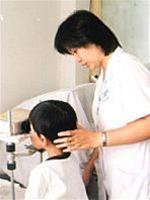Ocular injuries can occur due to accidents, sports, surgery, environmental pollution, chemicals, ultraviolet rays, or ionizing radiation. Severe injuries can lead to blindness; however, even minor eyelid injuries should not be underestimated. Unfortunately, very few people use protective eyewear or take measures to safeguard their eyes during activities.
From Severe…
|
|
|
Using laser systems to measure and treat refractive errors in children at the Central Eye Hospital (Photo: TTO) |
One alarming issue today is that many children are suffering from various types of ocular injuries. These injuries not only severely affect the physical and mental health of patients but also lead to costly treatment expenses. Currently, 5% of blindness cases worldwide are due to injuries. In our country, eye injuries rank as the second leading cause of blindness, accounting for 12.4%, following cataracts.
To date, there are no official statistics on the number of eye injury cases in general, and specifically for children. According to the Ho Chi Minh City Eye Hospital, the age group most frequently admitted for eye injuries is between 7 and 12 years old. Many cases have had their lenses replaced, but the chances of vision recovery are low due to potential cataract formation from the replacement, which carries a high risk of blindness.
Common conditions include corneal tears leading to cataracts or lens rupture, globe rupture, eyelid lacerations, and lacrimal duct injuries. Notably, there are cases of multiple injuries, including those caused by explosions or sharp objects. Many cases have been treated urgently, yet blindness remains unavoidable. According to statistics from the Ho Chi Minh City Eye Hospital, summer is the peak season for children being hospitalized due to eye injuries. The Hanoi Eye Hospital also reports a significant number of similar cases.
According to surveys by medical experts, ocular injuries often occur during labor, such as during rice harvesting (harvest season keratitis), and injuries during daily activities account for 7-60%. Sports-related injuries, which predominantly affect males aged 10 to 39, are on the rise. Accidents related to traffic are also trending upwards.
Due to a shortage of medical personnel and minimal equipment to assist in treating eye injuries, many patients do not achieve the desired results despite prompt treatment. One alarming issue in Vietnam regarding the management of eye injuries is the misuse of corticosteroid medications, leading to severe consequences.
… to Minor
Compared to other ocular injuries, eyelid injuries are considered less severe. There are various types of eyelid injuries. According to Dr. Nguyen Quoc Anh from the Central Eye Hospital, eyelid injuries can be isolated or associated with other injuries such as facial, orbital, and globe injuries.
As a principle, vision and globe condition must be assessed before treating eyelid injuries and surrounding structures. If the injury is severe, a CT scan of the head and face should be performed to comprehensively evaluate the damage, especially to rule out any brain injuries, particularly when it is difficult to assess consciousness impairment (in cases of intoxication or cerebral concussion). At the same time, globe perforation should be ruled out. Generally, globe injuries are often associated with eyelid and orbital injuries.
In reality, most eye injuries, whether severe or minor, can be prevented. According to ophthalmologists’ recommendations, individuals in situations that may affect the eyes should wear protective eyewear. Additionally, parents should closely supervise their children during the summer.



















































